The biggest story in land use in Charlottesville this year continues to be generated by the Cville Plans Together Initiative, an effort by a consultant hired by City Council to update the Comprehensive Plan and produce a new zoning ordinance to encourage and implement the creation of additional housing units. Council adopted a new affordable housing plan in March. That was the first item the firm Rhodeside & Harwell was tasked to complete. In this installment of Charlottesville Community Engagement, the sole item is a rundown of the Charlottesville Planning Commission’s June 29, 2021 work session on the plan. (download the presentation to follow along)
*
Support for this program comes from the quarter of the audience that has opted to make a financial contribution. My company is called Town Crier Productions, and the idea is to continue making podcasts and newsletters about the community, continuing on my career doing nuts and bolts journalism about how things work. Or don’t work! I do know my work proceeds better if I can pay my bills, so do consider subscribing through Substack or becoming a contributor through Patreon. If you go the Substack route, Ting will match your contribution. And if you have already, or you can’t do so? Please let your friends, family, and co-workers know about the program and let’s grow the audience together!
The Cville Plans Together era of the update of Charlottesville’s Comprehensive Plan has been underway now since January 2020. Community engagement plans suffered when the pandemic struck America two months later, forcing public input sessions to be virtual. Despite that, the City Council adopted an affordable housing plan in March, and the initiative held a six-week public input process which concluded on June 13.
On June 29, Cville Plans Together held another virtual work session with the Charlottesville Planning Commission to go through what they learned. But that work session began with an introduction from the newest member of the seven-member advisory group. Let’s hear from him.
“Hi everyone! My name is Karim Habbab and I’m honored to be part of the Planning Commission. I moved to Charlottesville in 2011 as a UVA student and graduated from the architecture school there in 2015 and started working with BRW Architects in town. It’s been six years with them and I’m excited to join this Commission at an exciting time.”
Habbab is the latest Planning Commissioner to join the process while it is underway. Liz Russell joined the Commission last September to replace a vacancy around the time the initiative was in its second round of community engagement. There are only two Commissioners remaining from when the review began in January 2017.
Jennifer Koch of the firm Rhodeside & Harwell is the project manager for Cville Plans Together.
“This was our third engagement period for Cville Plans Together, but we’re building on earlier work completed by the Planning Commission from 2017 and 2018 with this Comprehensive Plan update process,” Koch said.
There were multiple ways to communicate, including an online survey, direct correspondence with the engagement team, and the ability to leave comments on an interactive version of the Future Land Use Map. More on that in a moment.
For the first time in the Cville Plans Together era, the receding of the pandemic meant there could be some in-person events in this third period.
“We held six pop-up events over two weekends, mostly between May 14 and May 16 and we had a lot of face-to-face conversation at these events,” Koch said.
There were also two webinars during the public engagement session. A meeting with interested neighborhoods was held on May 18 and the project’s steering committee met on May 19. (read an article about the latter)
More than 400 people responded in an online survey but the majority of comments were made via direct correspondence
“We received about 1,130 emails,” Koch said. “This is a lot of email comments and that’s great. It’s a lot more than we received in previous phases.”
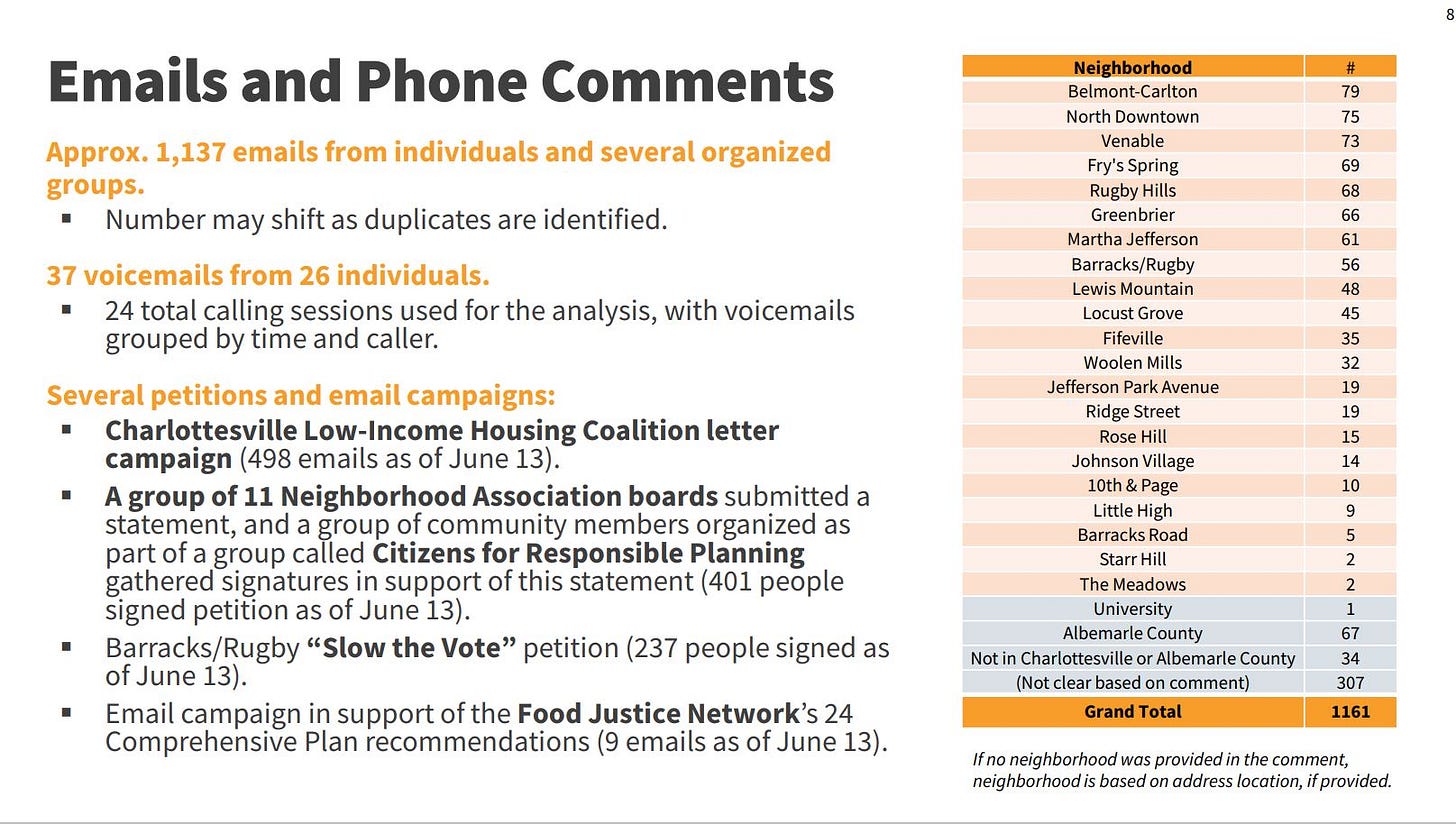
Koch said the Charlottesville Low Income Housing Coalition led a campaign that generated about 500 of that number through June 13. A new group skeptical of the plan called Citizens for Responsible Planning sent in a petition with about 400 signatures, but that number is not reflected in the count.
There were over 700 comments from about 225 individuals on the interactive map, and around 430 responses to the survey. A full engagement summary is coming at a later date, so for now I’ll refer you to the slides for the preliminary breakdown.
There were also specific comments on the draft housing chapter of the Comprehensive Plan.
“A lot of the revisions we made in the housing chapter were focused on pulling in those recommendations from the affordable housing plan,” Koch said. “Sort of the main theme we heard about this chapter was a general support for increasing housing density or intensity, but then similar to the land use piece we heard some concerns about what that potential increase in density or intensity might mean, particularly related to community character.”
Ron Sessoms of Rhodeside & Harwell went through some of the feedback. He noted some of the feedback from the campaign by the Charlottesville Low Income Housing Coalition.
“There were concerns about displacement particularly among Black and low income residents throughout the city,” Sessoms said. “There was a desire for more density in historically exclusionary white communities. We received some comments that this Future Land Use Map wasn’t going far enough.”
Sessoms said there was also a push from this campaign to increase the number of units allowed per lot from three as depicted in the current draft to four or five.
Critiques of the plan were also received.
“There were concerns around transportation and infrastructure, particularly considering the increase in density,” Sessoms said. “There were quite a bit of concerns about developer intentions in implementation. Citizens are very skeptical of developers so there were concerns about whether or not with the increase in density and whether or not developers would take advantage of that and have negative impact to the community.”
Sessoms said there are also concerns about height in many of the newly created land use designations. He also said the feedback gives geographic data on areas that are not as sold on the plan.
“Neighborhoods that are proposed to be experiencing the most change had the most negative feedback so communities like Barracks/Rugby, Greenbriar, Lewis Mountain, north of downtown, Rugby Hills, those communities did have more negative sentiment around the future land use map,” Sessoms said.
Another theme in the survey demonstrates that how one feels about the Future Land Use Map depends on one’s financial relationship to where they live.
“Looking at homeowner versus renters, there was a higher degree of support for the Future Land Use Map from renters,” Sessoms said. “And less support from homeowners, again with homeowners citing concerns around property values, community character, and other concerns that directly impact the places that they live and they own. And renters see this as an opportunity to diversify where they can live in the city. Perhaps there are more opportunities to rent in communities and neighborhoods that were traditionally out of reach.”
Planning Commission Chair Hosea Mitchell opened it up to public comment before the seven Commissioners were allowed to give their thoughts. Let’s just hear two at the moment before hearing
Maddy Green, a new appointee of the Charlottesville Redevelopment and Housing Authority’s Board of Commissioners, wanted the Commission to know where comments critical of the draft map came from.
“Just noting that they came from a lot of communities that were exclusionarily zoned and had racial covenants in the houses and I think that we can see that residents are still advocating for those same policies and quite frankly they are racist policies in Charlottesville,” Green said. “Saying you don’t want affordable housing in your back yard or any kind of density is effectively saying you don’t want people who make less money in your backyard.”
As part of the engagement process, eleven neighborhood associations submitted a petition with over 400 signatures asking for the planning process to be slowed down. One of those associations was Johnson Village, where Kevin Hildebrand lives.
“It has gotten very expensive in the last few years as house prices have gone up but most of the single-family houses are still there and they are a vehicle for wealth development for families who have invested there and I think the idea of transitioning most of the city to apartments in multifamily dwellings where people don’t have the ability to improve themselves through home ownership is short-sightedness on the part of the city,” Hildebrand said.
Comments went back and forth on this line for a while before it went back to the Commission for questions and comments . They will be asked to recommend or not recommend the plan at a future public hearing. They first had the chance to ask questions. Later on we’ll hear their direct input.
Liz Russell went first and she had a question based on what one of the speakers had asked about the relationship between density and affordability.
“One thing I heard was questioning, one resident was questioning of upzoning that has occurred in places like Minneapolis and I think Chicago,” Russell said. “My understanding was that it’s sort of too soon to say but it sounds like there’s sine other reports out there and I’m wondering if the consultants could provide any insight.”
Jennifer Koch said the results are not yet in.
“In several of those locations I think some of those changes were done quite recently which does make it difficult to say as you mention,” Koch said.
Lee Einsweiler of the firm Code Studio will be taking the lead on rewriting the zoning code. He agreed with Koch’s assessment.
“I’m afraid that I have to agree with you,” Einsweiler said. “We don’t have a lot of information right now that points to any one given solution being the answer to this question but all of the ideas that are being presented begin to tackle the same problem. If you don’t have to have a car you can save $8,000 a year on average. If you can live in a smaller home, you’re paying less for your total square footage.”
On the same, Commissioner Taneia Dowell wanted a direct response to a related question.
“It was mentioned tonight during public comment and also as I’ve spoken to all different residents throughout the city is that I’m finding that our residents are feeling that the increased density and intensity that has been proposed is not actually going to solve our affordable housing crisis,” Dowell said. “What is your response for our constituents?”
Koch said that land use policy alone will not be the solution.
“I think it is great people are recognizing that and flagging that, but we’re trying to use lan d use potentially allowing for increased intensities or some mix of uses that will need to be paired with financial support and initiatives and other support in other ways from the city,” Koch said.
The director of the city’s Department of Neighborhood Development Services agreed with that sentiment.
“Land use is just a piece of the pie,” said Alex Ikefuna. “I’m encouraging the public to go out and read the draft affordable housing plan which is on the website. It spells out several recommendations, one of which is land use. Land use is just one of the few recommendations.” (read the Affordable Housing Plan)
The executive summary of the 158-page states that other recommendations are the designation of $10 million in city tax-payer funds to affordable housing projects each year and making the process more inclusive. The third major recommendation is devoted to land use under the name “Adopt Progressive and Inclusionary Zoning Reforms.”

Representation in responses?
One of the reasons a previous Council voted in February 2019 to spend nearly a million on the Cville Plans Together initiative was a lack of involvement with Black residents of Charlottesville.
As part of the presentation for the June 29 work session, the consultants broke down previous efforts for the entire Comprehensive Plan review so far since the first public input session in May 2017. At several events that month, 156 people signed in and 65.71 percent identified as white and 34.29 percent identified as Black.
In a survey conducted in September and October 2018, there were 1,182 responses. Nearly three quarters identified as white and 15.84 percent identified as Black.
The first community engagement phase of the Cville Plans Together initiative continued a trend toward less participation among Black residents. A survey conducted online in May and June 2020 yielded 1,172 responses. Sixty-three percent identified as white, 11 percent identified as Black, six percent preferred not to answer and another 12 percent left the question blank.
An online survey conducted in November and December last year had much fewer participants with 274 responses and over a third left the box for race and ethnicity blank. 108 of the respondents said they were white and 44 said they were Black.
In the current survey, sixty-six of 430 survey respondents identified themselves as white and 24 percent left the item blank. Only 2.3 percent identified as Black.
This raised a question from one Planning Commissioner.
“A big concern from 2017 was diverse representations especially for Black and low-income representation,” Solla-Yates said. “What do we do?”
LaToya Thomas of sub-contractor Brick and Story said there was a lot of skepticism in the community built up over decades.
“I think particularly among the Black residents that we have spoken with, there’s a lot of skepticism around the public process over all,” Thomas said. “There’s a lot of skepticism around the city and obviously a very long time frustration for what many folks feel is a system that’s set up to not serve them adequately.”
Thomas said the pandemic made it difficult to do many of the community engagement activities that had been planned.

When it was his turn, Commissioner Jody Lahendro noted that the Future Land Use Map depicted some areas currently designated as “low intensity residential” to the “medium intensity residential” category which would allow up to eight to 12 units per lot with building heights of up to four stories. In his question, he quoted the provision in Virginia code that requires Planning Commissions to prepare and adopt Comprehensive Plans. (read the code)
“For me as a design professional, this seems like a drastic change that’s a conflict,” Lahendro said. “Please help me understand as professional planners how this represents as the code of Virginia says ‘a Comprehensive Plan that’s ‘a coordinated, adjusted, and harmonious development’ based on good land use practices.”
Koch said the goal is to increase housing stock based on public input.
“We have heard an urge to have additional housing types allowed or available to people in some neighborhoods where they have not been available,” Koch said. “The way we have decided to show it is along corridors because we feel that can help to facilitate transit-oriented growth where we are potentially allowing additional density that could also help to facilitate other infrastructure improvements that may be needed to go with that.”
The corridor approach expands on the last major rezoning in 2003 which created specific zoning districts such as West Main Street, Cherry Avenue, High Street, and more. This followed the 2001 Comprehensive Plan, which frequently refers to a 2000 study called the Commercial Corridor Study. (read about this study on cvillepedia)

Sessoms said the details will come as detailed work on the zoning takes place.
“In the future land use map, it’s very general and we have ranges in heights of up to four stories, up to 12 units per lot, and that allows this greater flexibility to define more specific zoning districts in the zoning phase,” Sessoms said. “It certainly would not appropriate to have four stories in every location that we show in medium-intensity residential because it would be out of character, out of scale and just not befitting.”
Lahendro also asked what tools were in place to prevent displacement and further development in Black and low-income communities. Koch said there are tools identified in the affordable housing plan.
“You know, providing tax abatement, or support for owner-occupied rehabilitation, support for people who may want to add an [affordable dwelling unit],” Koch said.
Koch said that allowing density in other sections of the city could assist with the issue as well.
Meanwhile, it is instructive to note that many properties in those neighborhoods continue to sell to owners with the ability to pay large amounts of money for the existing single family homes that are currently there. Here are some recent examples.
A home in the 300 block of 5th Street SW in Fifeville sold on May 28 for $520,000, which is 32.35 percent over this year’s assessment.
A home in the 800 block of Anderson Street in the 10th and Page neighborhood sold for $575,000, which is 75.73 percent over the 2021 assessment of $327,200.
In the Rose Hill neighborhood, a home in the 900 block of Henry Avenue sold for $255,000, or 82.8 percent over the 2021 assessment.
Commissioners weigh in
Commissioner Liz Russell wanted more information on the possibility of an affordable housing overlay district, something that will be discussed at the July 13 meeting of the Planning Commission.
“I have concern that density for density’s sake will not result in what we are trying to achieve but that something like an affordable housing overlay could tip the scales in favor of affordable housing,” Russell said.
Commissioner Rory Stolzenberg pushed back on comments from the Lewis Mountain neighborhood about additional residential density that would be allowed under the middle intensity residential category.
“To me I think that a 12-unit apartment building or a six-plex or an eight-plex is small enough that it doesn’t really have any super appreciable adverse impacts on the neighborhood and an apartment building, a small apartment, is not going to hurt you,” Stolzenberg said. “And as well there are some concerns about physical constraints on lots. We have site plan review processes that will ensure there’s adequate infrastructure, sewer, and water.”
Commissioner Dowell returned to the theme of protecting Black neighborhoods from further investment from outsiders.
“We do not want them to be gentrified out of the neighborhood and we also know to make sure that we reiterate time and time again that homeownership does create generational wealth,” Dowell said.
Commissioner Lyle Solla-Yates brought up a transportation matter.
“A major concern that I’m seeing from very high income people is traffic,” said Solla-Yates. “They live in their cars. They think most people live in their cars and for many they’re right. They are skeptical that we are going to make a transition and based on our past, they’ve got a good argument.”
A lot of the conversation was influenced by an alternate Future Land Use Map that has been put forward by members of the Housing Advisory Committee outside of the formal public comment period that closed on June 13. The idea was discussed at the June 16 HAC meeting. (watch the meeting)
Here’s a brief overview:
Much of Fifeville, 10th and Page, and Rose Hill neighborhoods would be designated as a “low intensity residential” category with “a range of housing types scaled in context with the existing single-family character.” The idea would be to preserve homes in the center of the city in neighborhoods historically populated by low-income housing.
The proposed medium-intensity residential designation would apply to every single residential district across the city if a certain amount of below-market units are provided by the developer.
High-intensity residential would be allowed in more site-specific areas, if a yet-to-be-determined number of below-market units are provided.
Commission Chair Hosea Mitchell had positive thoughts about the idea, which will be discussed by the Planning Commission at the end of their meeting on Tuesday, July 13.
“The ability to protect the low-income communities but be a little more thoughtful in the way we increase density in places like Greenbrier and Lewis Mountain,” Mitchell said.
Mitchell also said he supports efforts to work with other communities in the Planning District. The Central Virginia Regional Housing Partnership has a draft plan called Planning for Affordability that is going through the approval process. (read the plan)
The meeting concluded with over an hour of additional public comment. To finally get this newsletter out, I’m going to skim through this for now. There will also be more opportunities for public comment as the plan continues to move through the various public hearing processes. If you want to watch the public comment from the June 29 work session, here’s the link to do so.

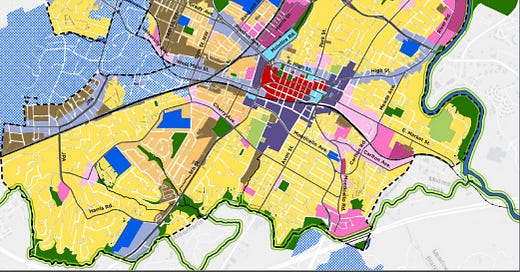



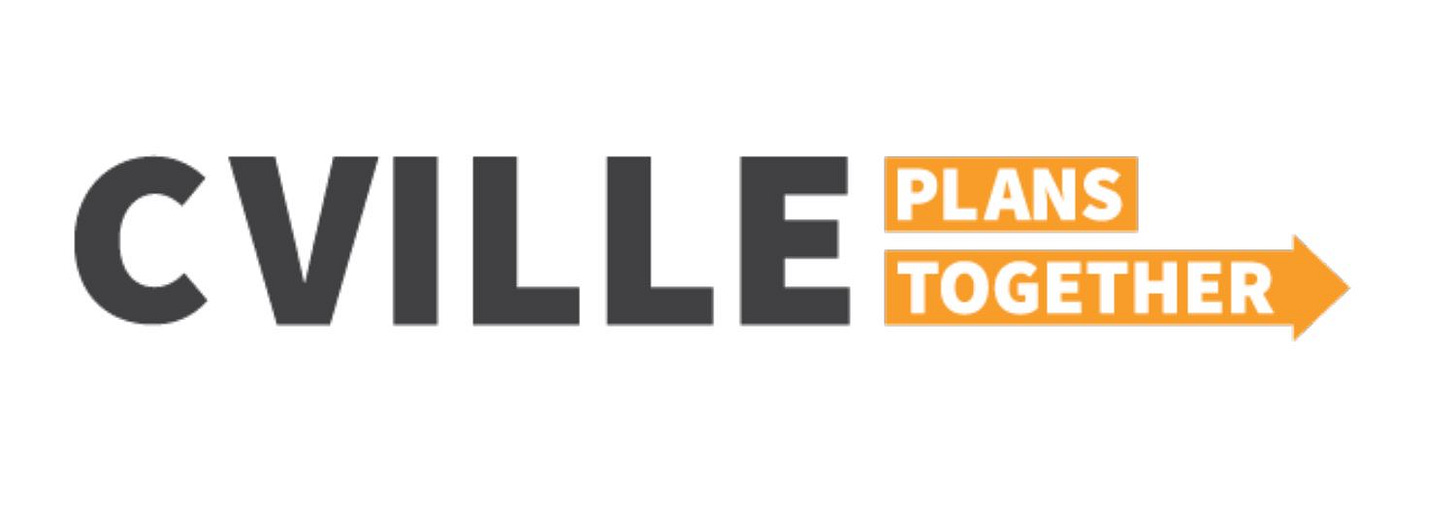
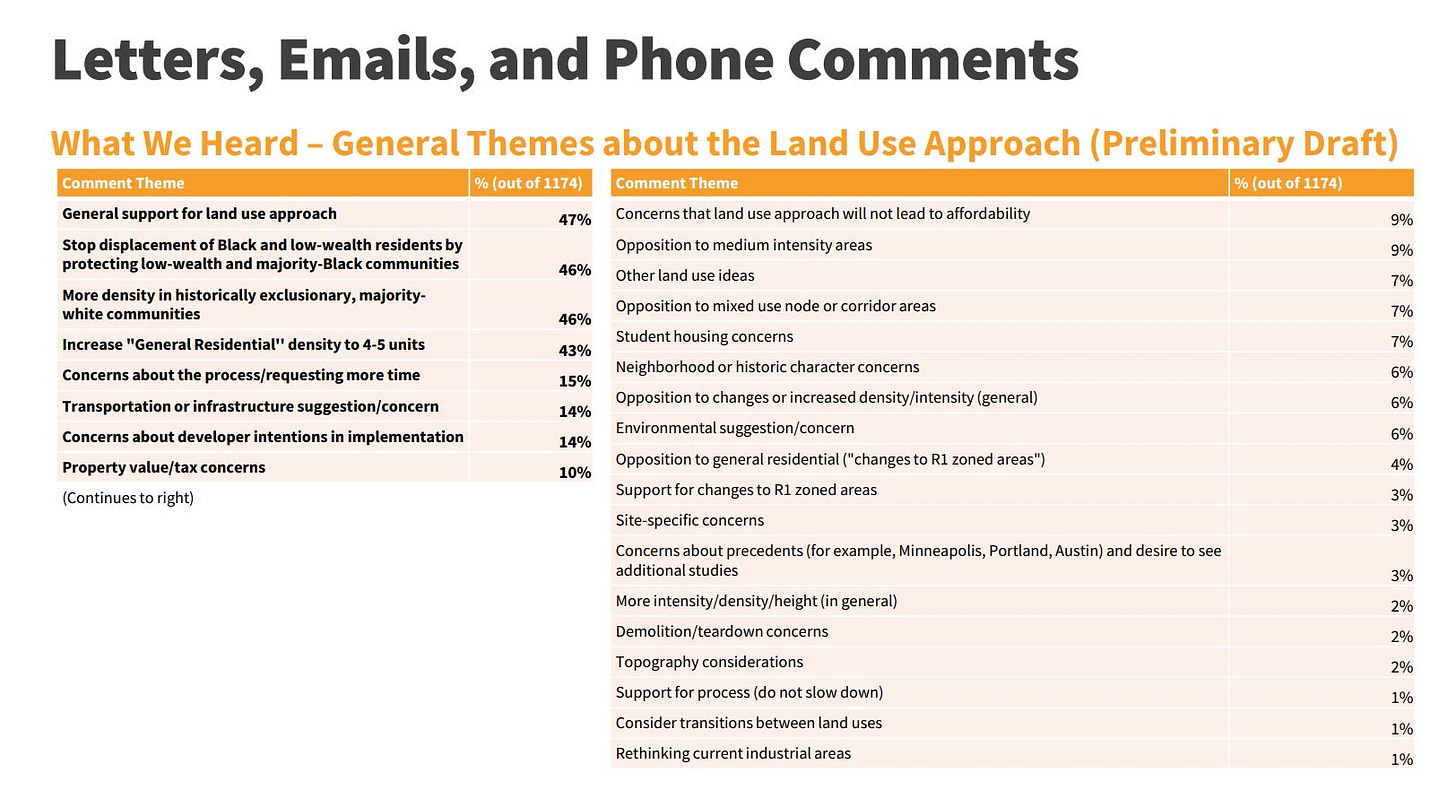










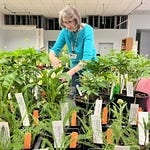
Share this post